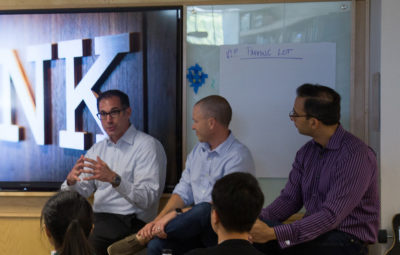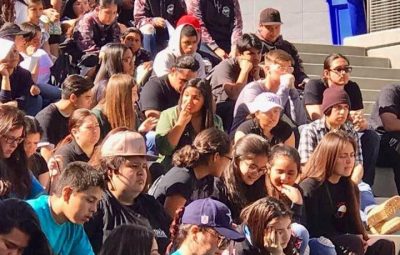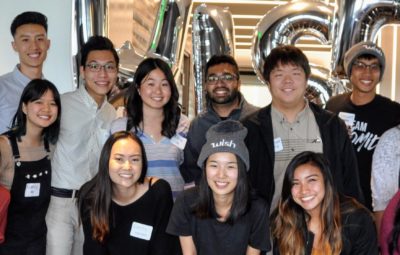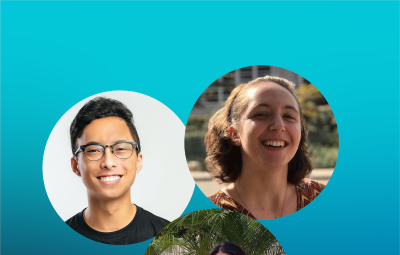As humans, we tend to compartmentalize ourselves as being either logical or creative thinkers. Rarely do we realize that everything we contemplate and create is better when we are both. This unification of both solutions-oriented entrepreneurship and nonlinear design thinking is the foundation of a new UC San Diego student program called the Idea Lab.
The program is a part of UC San Diego’s commitment to being an innovation catalyst and to cultivating future leaders, according to Michèle Morris, Associate Director of The Design Lab. “The Idea Lab program focuses on preparing our students to step into the 21st-century job market with the mindset and skills needed to address today’s challenges with solutions that are not necessarily directed and linear,” she explains. “Being able to navigate ambiguity, engage strategically and collaboratively with diverse stakeholders, and tactically operate in an inclusive, wholistic manner is no longer simply important, it is essential.”
A Collaboration for the Future
The Idea Lab pilot program was launched in Fall 2020 and is itself a collaboration between two unique centers within UC San Diego’s innovation ecosystem: Office of Innovation and Commercialization (OIC)/The Basement—a student startup incubator that provides entrepreneurial and leadership programs; and The Design Lab—an interdisciplinary research and education community that prioritizes how humans are impacted by complex systems and technologies.
It is bridging these two worlds that Design Lab Industry Strategist, Emily Knapp, says is what the 10-week Idea Lab program aims to do. Knapp explains that rather than the popular Silicon Valley motto of ‘move fast and break things,’ the future requires “the next generation of students to be a different type of leader; leaders who are immersed in values around ethics, equity and sustainability. These are the things that our students really care about.”
Jacques Chirazi, Director of Student Entrepreneurship and LaunchPad with The Basement, the Idea Lab program is about going beyond just the technical skills. “I think it is about transferable skills; [students] building confidence in themselves; in their ability to solve very complex problems; to be creative; and to think about other avenues that they never thought of.” He explains that traditionally, The Basement has been effective at helping entrepreneurial-minded students “grow from an idea stage, all the way to a prototype in a company,” but the partnership with The Design Lab takes it a step further by providing a more inclusive opportunity for all students from across disciplines and interests to collaborate in solving problems. “We’re doing the same thing we usually do,” explains Chirazi, “but The Design Lab is focusing on the design thinking process, and we’re focusing on the entrepreneurial journey, so combining those two makes perfect sense and allows us to reach a larger audience on campus.”
Since the program is relevant to any student, not just those with an entrepreneurial spirit, it provides students a way of thinking of the problem space more deeply, according to Gloria Negrete, Director of Strategy. “With this Idea Lab program, we have an opportunity to […] engage students who may not identify as entrepreneurs or innovators but who want to develop transferable skills, and work on interesting projects where they create new solutions that could impact local communities and beyond.” She says the strength in the collaboration between The Basement and The Design Lab has been sharing best practices, exchanging resources across teams, and more importantly working collaboratively to evolve the program based on student feedback. “Students are being taught to use customer feedback to develop solutions,” says Negrete, “and it’s the same approach applied here in developing the program.”
What Student Participants Say
One student who participated in the first cohort of the Idea Lab program was Will Landry, who graduated with a BS in Biology and is the Founder and CEO of The Lichen Lab Co. He says there is a certain “hype” around being an entrepreneur that feels like a box. “What I think is hard to present is a more inclusive program […] for folks who don’t feel like that label fits them. This program has proven to be a really good home for them.” After his experience in the program developing a proof-of-concept drone project for ocean swimmer safety, Landry says the value of the opportunity cannot be overstated. “Regardless of whether students go that entrepreneurial route or not, just having a space to actualize creativity that isn’t under one sort of box is wicked important.”
For Laura Charria, another program participant who is a first year Cognitive Science major, entrepreneurship was the focus. “I went to the Idea Lab to create a dog walking app, which was an idea I had in high school, and I wanted to see if that idea could be validated,” she explains. “From an early entrepreneur perspective, I have enjoyed exploring ideas of interest and putting them in the design perspective. […] It’s this iterative process where we get to experiment and bring our ideas to life.” For her, the program’s value was the “opportunity to broaden our perspective, meet new people, test our idea and become better designers.”
A designer, in this context, is not what most people think of when they hear the word. Tanisha Roy, a Cognitive and Behavioral Neuroscience major, says she didn’t know anything about design when she joined the team as one of three student Co-Creator’s for the Idea Lab. “To me, design was blueprints that you see on TV. It was very clichéd, definitely not what design actually is.” After participating in a different Design Lab project, Roy leveraged that experience and now collaborates with fellow students, Lisa Zhou, who is the program’s team lead and a fellow Cognitive Science major; and Sneha Lakshmanan, the program’s mentor relationship manager and a 2021 graduate with a BS in Biology and Bioinformatics. As the Idea Lab’s student experience champion, Roy says that her understanding of what students need as they navigate the program has been crucial because the concept of design thinking can initially be overwhelming for students. “Ambiguity is really great, and it’s a huge part of design, but as a student it’s terrifying because you’re like, ‘If it’s ambiguous, I don’t know where I’m going with it,’” she explains. “A lot of what Sneha, Lisa and I were focused on was talking to these participants, seeing what was really bothering them or what they really loved during that process, and trying to make sure they were not always trying to follow that linear path.”
The Importance of Combining Design Thinking with Entrepreneurship
Design thinking is nonlinear with the ability to pivot, according to James Biggs, Founder and CTO of Taction Technology and one of the Idea Lab’s student mentors. “At this level of design, there’s a lot of checking your assumptions,” he explains. “Is this the problem I should be solving? Should I be trying to solve it for these people or those people? If I were to create this, what would the social effects be?” Biggs explains that things like industry and social media have had large social impacts, including climate change or intensifying conflict. “And those all stemmed from core assumptions. […] If you’re an engineer and all you’re thinking about are the bearing cylinders, and not the impact on the planet, we’re in trouble,” he explains. “Design is the kind of field where it can lead people to question their assumptions and try to design good things that have good consequences in the world.”
Design and entrepreneurship is all about the mindset, according to another Idea Lab mentor, Helder Sebastiao. As an Innovation Consultant and Startup Advisor with Lean Liftoff, he says “The world’s trickier and much more complicated than what linear thinking has gotten us to. We need to change the frame from which we look at problems; from how we look at different kinds of solutions.” This is precisely the kind of training students are getting as Idea Lab participants. Sebastiao says this way of thinking is what has staying power, adding, “Whether it’s launching a product or career decisions in the future, this process that they’ve learned has given them a different way of thinking about things and that’s so powerful.”
Confidence Through Community
With Fall ’20 and Spring ’21 pilots complete, the Idea Lab program is already bearing fruit, with approximately 30 students completing the program with successful outcomes. As a collaborative effort, Knapp emphasizes that the Idea Lab is a “co-designed” project, meaning it’s not just The Design Lab and The Basement sharing resources, but mentors and students all have a say in how the program is designed, which has produced some unexpected positive results. Mentors have not only connected students to internships, which is not a requirement of the program, but they have also helped their mentees with industry contacts that can help advance their initial ideas. “That’s well beyond what we could have ever expected. […] It is what has made the experience so rich for our students,” says Knapp.
The program’s impact can be attributed to the supportive peer and mentor community that the Idea Lab has nurtured, according to Christine Liou, Assistant Director of Operations at The Basement. She says “Just hearing all the student’s testimonials are really a true testament to why we created this program. We really wanted to have a safe space for students just to explore, test around, learn new things, meet one another and to continue to build our ecosystem here at The Basement and the larger UC San Diego community.”
Participants like Hilya Khalil, who is a fourth year Cognitive Science Design Interaction major, agree that the community plays an important role. She says her mentor helped her home in on a project where she felt she could have the greatest impact, which was creating a mentor STEM program for middle school girls. “I think the [Idea Lab] is just an amazing way to do that, as you have the support of all these peers that are as motivated as you,” she explains. “I just really love the community.”

Hilya Khalil presents virtually at the Idea Lab Showcase
Anna Dan, a fourth year Urban Studies and Planning major, says, “The community aspect of this program was probably the best thing.” Her project was to develop an app idea she called, “Curious Me,” which empowers children to take control of their curiosity by enabling them to ask questions directly to professionals. “While I love to express myself creatively and try to create and ideate, it’s really hard for me to do that alone, so I love that I was able to have that support from the entire cohort, working together whenever we had the opportunity, and I think that’s probably something I want to pursue later on.”
Both Dan and Khalil say the experience gave them a confidence they didn’t have prior to joining the program. “The most impactful thing that I got from this program is that I was truly able to see my value and my ability to actually be creative, because I really didn’t have that much faith in myself,” says Khalil. After she completed the program, she became the team lead for Design for America on campus to continue to utilize what she has learned. Dan says the program gave her “the critical thinking skills, the confidence, and the ability to work within a collaborative environment.”

Anna Dan presents virtually at the Idea Lab Showcase
Preparing for What’s Ahead
“At the end of the day, the goal of this program is absolutely, yes, learn about entrepreneurship, learn about design, understand how to move through these processes and how they can help you be successful anywhere,” says Knapp. “But, ultimately, it’s for our students to feel confident now in their creativity, their problem-solving abilities, and in their critical faculties. That means that they can take on even more aggressive and harder challenges in the future, and that’s what we need.”








